
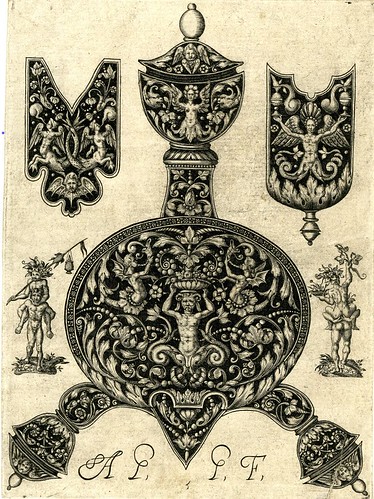
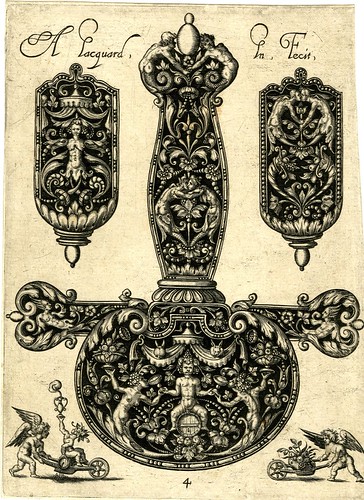

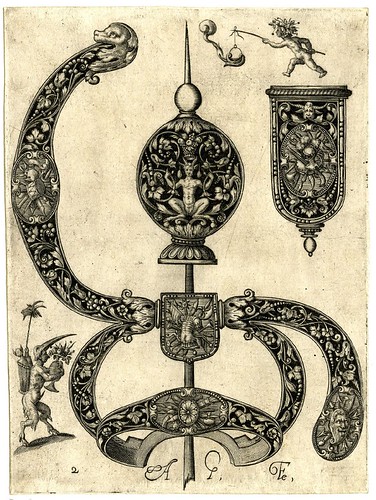
A set of plates by Antoine Jacquard representing designs in blackwork for sword handles, dagger hilts and pommels, decorated with abstracted foliage, grotesques, chimeric figures and drolleries. Produced between about 1610 and 1630. [source]

Dagger hilt with mushroom-shaped pommel featuring a grotesque mask and recurved quillons with ends scrolled like rams' horns; one of five designs for dagger hilts and pommels, from the 'Jewellery Book' by Hans Holbein the Younger in black ink and grey wash. Dates to around 1537. [source]
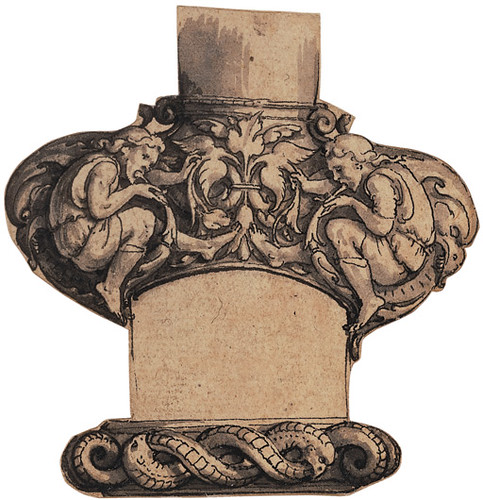
Another Holbein sketch from the from the same [~1537] 'Five Designs for Dagger Hilts and Pommels' series in which he has shaped the pommels and guards of these highly-finished designs from a variety of motifs in his repertoire, fitting grotesque heads, musicians, acanthus leaves, scaly tentacles and rams’ horns with flowing ease into the required forms of the dagger hilts. [source]
It is thought that one of the most important dimensions of Holbein's tenure at the English royal court was ornamental weaponry design. These hilt types bear stylistic similarities to, for instance, the kind of dagger seen in the drawing of King Henry VIII on this page from the Tate Holbein exhibition site.
{slight tangent: It is probably no little coincidence, then, that the Swiss artist, Urs Graf, incorporated Holbein's famous Danse Macabre figures into an engraved dagger and scabbard design}



Dagger hilt and sheath designs by Heinrich Aldegrever from the late 1530s with acanthus foliage and grotesque motifs. [images spliced together from screencaps] [source]
{Aside: As I recall, Aldegrever wasn't the only artist to copy the Dürer monogram design}
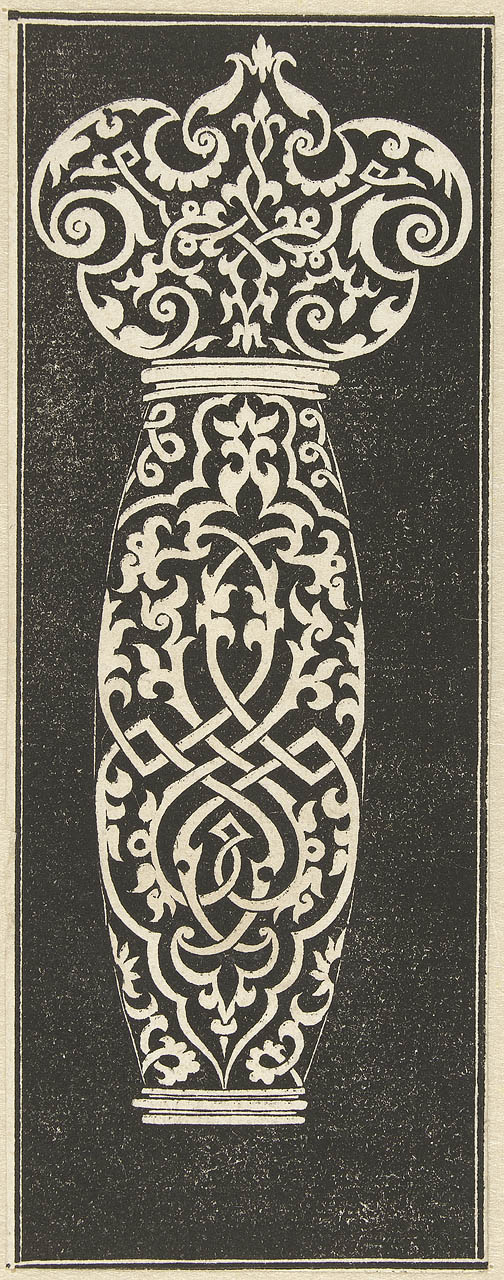


Peter Flötner* hilt designs featuring arabesques, grotesques, trophies and weapon mascarons from the first half of the 16th century [source]
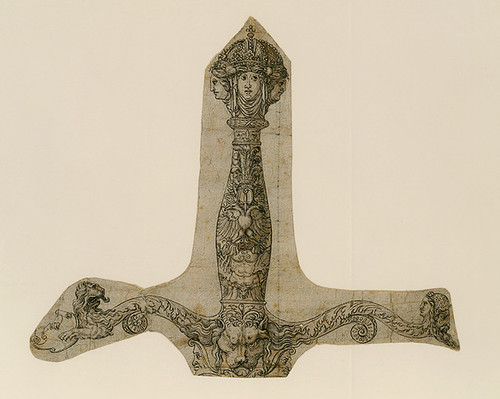
"Original designs for Renaissance swords are exceptionally rare, although notable examples by such renowned artists as Hans Holbein the Younger and Giulio Romano are preserved. Previously unrecorded, the present drawing is a significant addition to this small corpus and is a work of art in its own right. The style and iconography point to Nuremberg and possibly to Peter Flötner* (ca. 1485–1546), one of that city's most versatile artists.
Of robust proportions, the hilt was presumably intended as a side arm to be executed in chased silver or gold. The pommel is conceived in the round with four female heads beneath an imperial crown, while the grip is embellished with a double-headed imperial eagle incorporated into a classical trophy of arms. The guard, formed of undulating branches of acanthus leaves and scrolls, is asymmetrical, one quillon ending in a shield-bearing demi-lion and the other in a Janus head. A lion's head at the intersection of the quillons anchors the composition.
The design is novel and has strong Italianate features, hallmarks of Flötner's oeuvre. The trophies in particular recall one of the artist's woodcut designs for a dagger grip. The distinctive crowned pommel, on the other hand, is virtually identical to one in the design for a sword of Emperor Charles V that is dated 1544 and ascribed to the celebrated Nuremberg goldsmith Wenzel Jamnitzer* (1508–1585). The present drawing, however, reflects none of the Mannerist aesthetic of Jamnitzer's art and is clearly by a different hand and probably of a slightly earlier date. However, the presence of the imperial iconography suggests that it too was created for Charles V." [source]
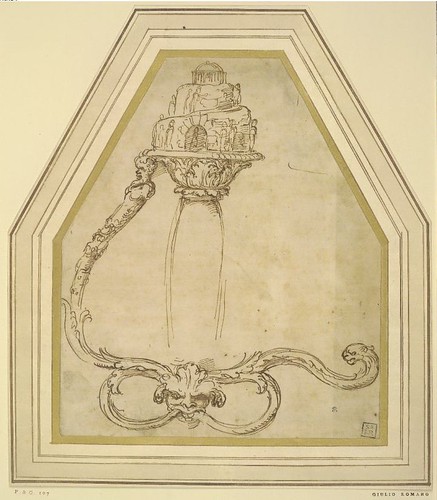
A sword hilt with the pommel in the form of a mountain surrounded by a spiral path leading to a temple, drawn by Giulio Romano in pen and brown ink between about 1520 and 1546. The Mount Olympus, as represented here, with the addition of the words "Fides" and "Olympus", was an impressa of the ruler of Mantua, Federico II Gonzaga* (this detail both helps date the design and gives some - although not conclusive - indication of its origins). [source]
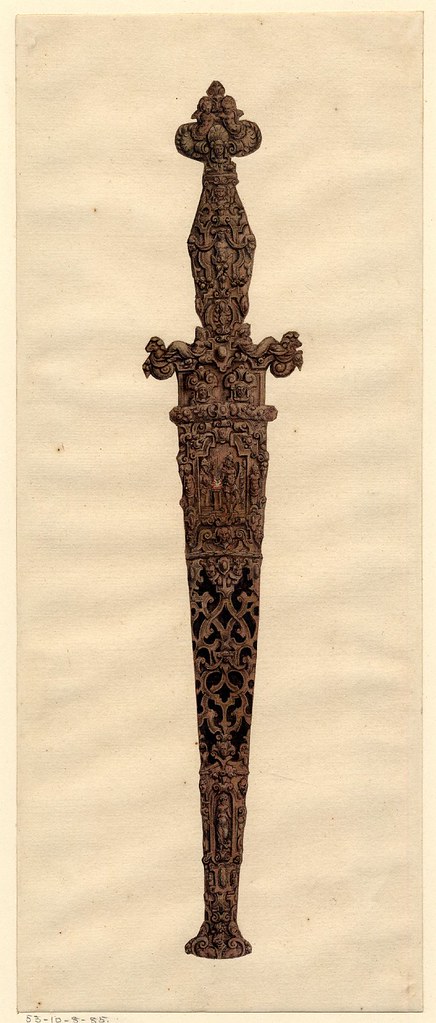
1550s design for a dagger and sheath by Wenzel Jamnitzer in brown and black ink, graphite, grey wash and gold hightlighting (the fire). The weapon is decorated with 'the defiance of Mucius Scaevola'*, grotesque figures and an interlace of arabesques, among the many intricate ornamental details. [source]




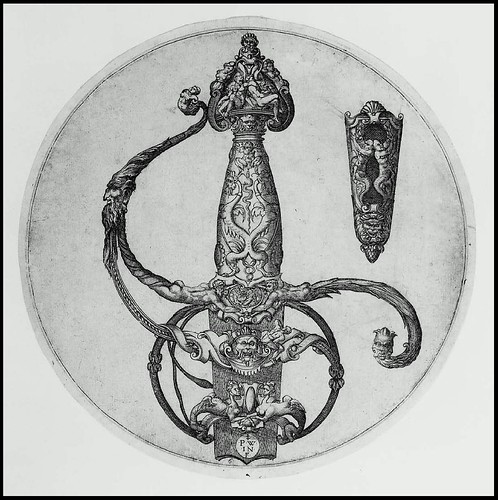
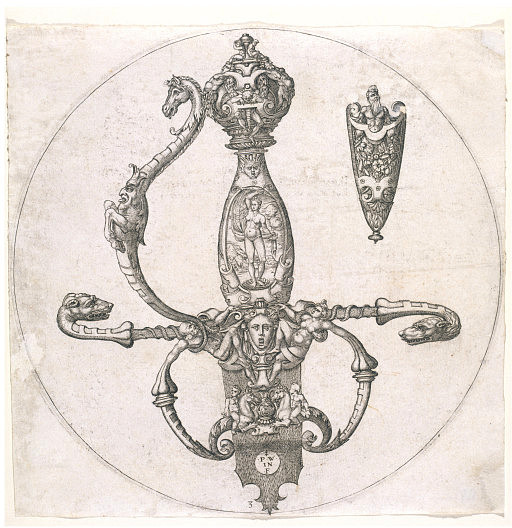
"This engraving, designed and engraved by Pierre Woëriot, shows a handle and a guard for a sword. The design is inspired by the grotesque, with imaginary creatures bending into the swordhilt. The original design drawing is also in the Museum’s collection (Museum no E.664-1929) this is a copy with slight variations.
Ornament designs like this were copied by artisans and craftsmen. The theme of the grotesque was a popular one around this period. Grotesque derives from the Italian word grottesco. The style was inspired by ancient Roman designs discovered at the end of the 15th century in the underground rooms, or grottoes, of the Golden House of Emperor Nero in Rome. Grotesque ornament was used to decorate a wide range of objects, such as ceramics, and the style was much copied by Renaissance artists."
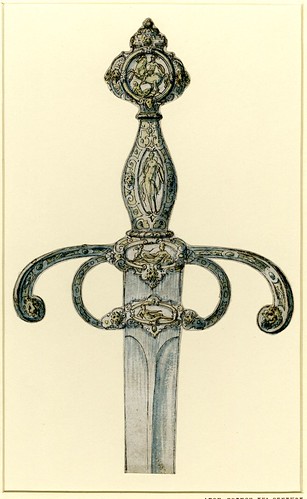
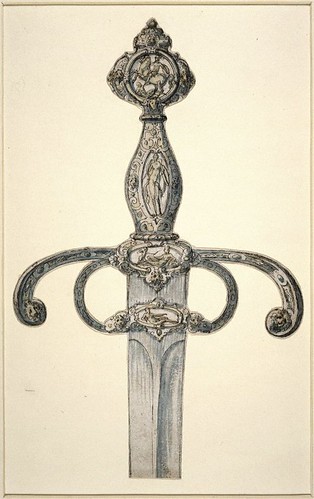
The above eight incredibly imaginative sword and dagger hilt designs featuring a wide range of structural and ornamental motifs such as chimeric figures, nudes, acanthus leaves, grotesque masks and animal heads. The designs, from about the 1550s and 1560s, are by the French goldsmith and artist Pierre Woeiriot II [Woëriot] (the last couple are either by, or modelled after, Woeiriot's work). [sources: BM, MFA, RM, V&A]
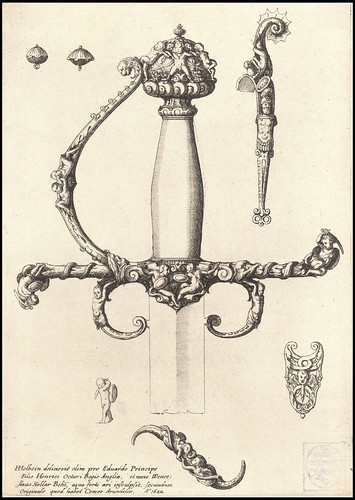

Sword, dagger and scabbard designs by Hans Holbein the Younger and engraved by Wenceslaus Hollar. They date to around the 1640s. [source]

Hilt design in brown ink and inkwash, graphite and white chalk by Polidoro Caldara (aka Polidoro da Caravaggio) from around 1510 to 1540 [source]
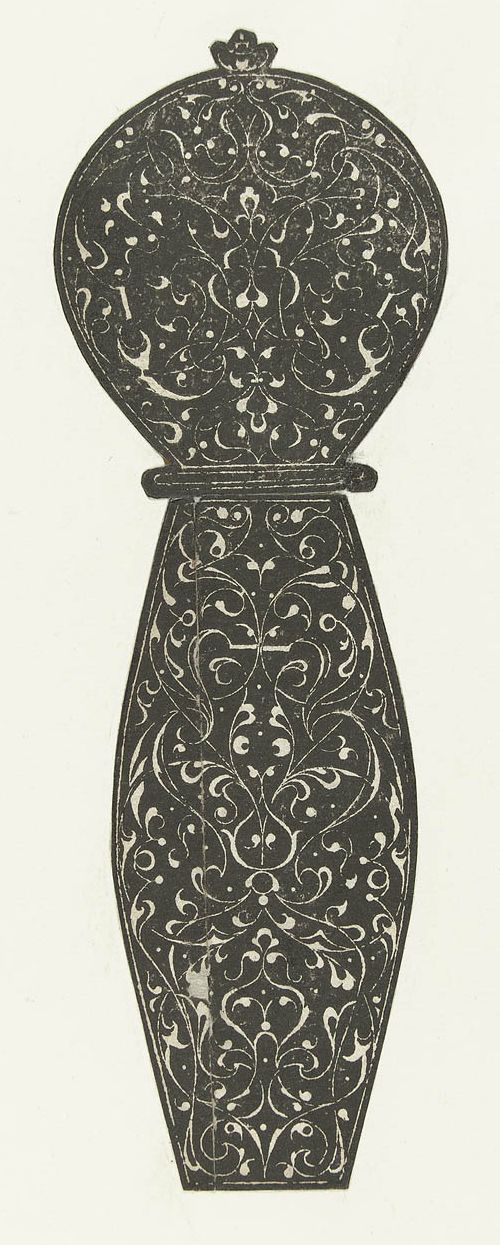
Sword hilt, from the mid-1500s, designed by Bernard Salomon featuring arabesques. [source]
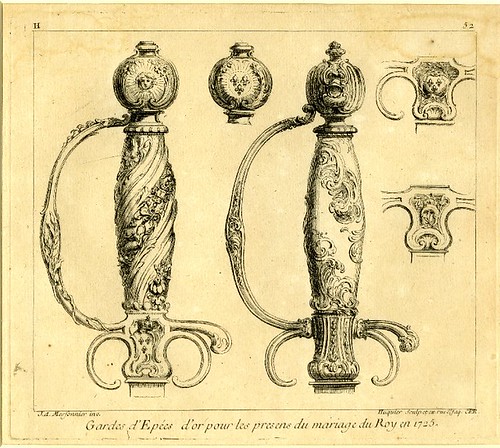
This is a republished print from a 1740 series by Gabriel Huquier called 'L'Oeuvre de Juste-Aurèle Meissonnier'. The original Meissonnier designs had been commissioned for rococo goldsmiths: one of these swords was produced for the 1725 wedding between King Louis XV and Maria Leszczyńska of Poland. [source]
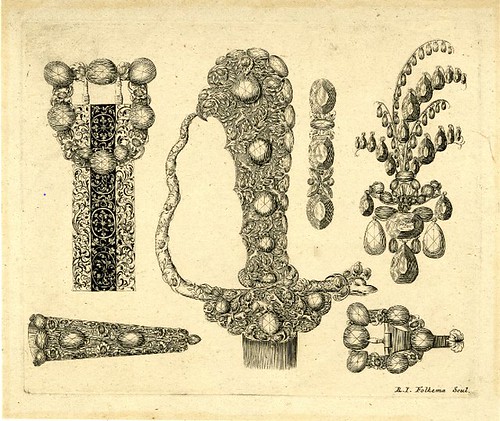
Belt, hilt and sundry jewellery designs engraved by RJ Folkemma from the series, 'Liüre de Feüillages et d'Ouvrages d'Orfevrerie Inventees par JL Juge', first published in about 1670 [source].
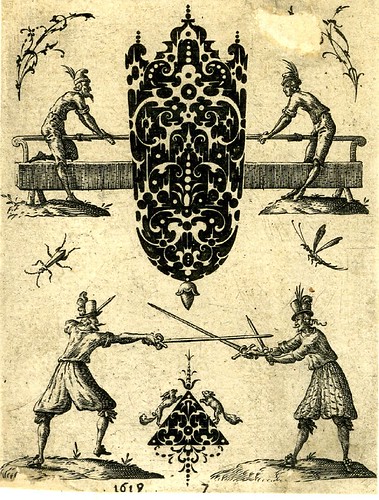
Design for a hilt in blackwork with pea pods surrounded by two goldsmiths, and a small scene with two swordsmen fighting [1619]. From a small and beautiful series by French enamel-worker, Jean Toutin* [source]
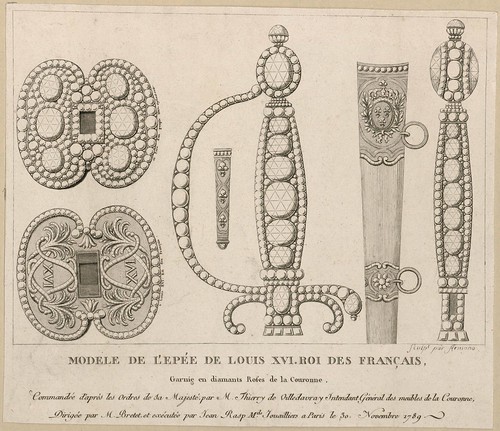
Model of Louis* XVI's coronation sword embellished with rose diamonds. Engraved by Armano in September 1789 (!). [source]

Ornamental dagger hilt design in ink and inkwash, produced in Patna (India) in about 1800. [source]

Hilt design in ink and coloured chalk, produced in Rajasthan (India) in the 17th or 18th centuries. [source]
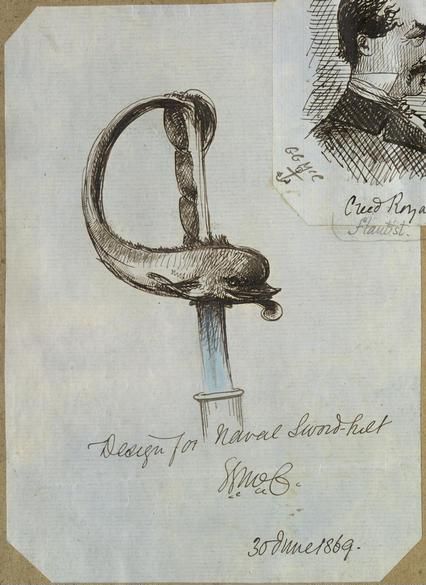
Design for a naval sword hilt from a watercolour and ink album produced in the late 1800s by GG McCrae* [source]
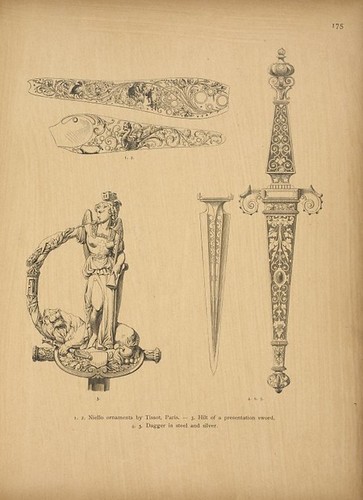
This plate from an 1880s pattern book for jewellers by A Fischer features various jewels by Tissot as well as the design for a presentation sword hilt. [source]
[In most cases you can click through to an enlarged version. Some of the images were very mildly background cleaned. All those with a black surrounding border were spliced together from screencaps]
This is, without question, a woefully inadequate overview and selection and I probably could have spent another week sifting for further images. I was heartened to read the Met. Museum blurb advising that there aren't that many original Renaissance-era hilt designs around.
- Sword definitions & terminology at the Association for Renaissance Martial Arts.
- More sword and blade terminology at Real Armor of God.
- Wikimedia: swords in art.
- Sword Forum International and their fairly extensive link pages.
- Doug's Rapier Hilt Making page (from 1998)
- Previously (vague associations) combat & artistry.
- UPDATE: Some great 1860 plates of hilts by Alexandre Gueyton at la Médiathèque André Malraux de Lisieux
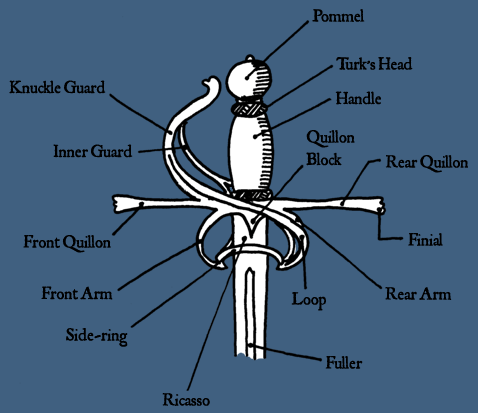
No comments:
Post a Comment